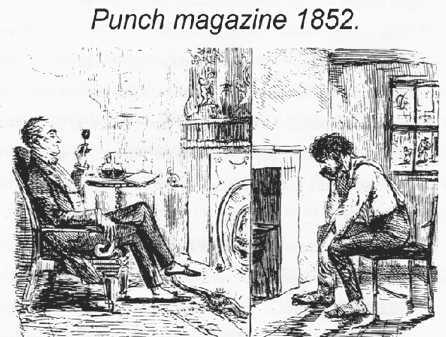PONTYPOOL GLYN PITS
Social History

This illustration depicts a two-sided look at the ruling classes and those who were being used to gain profits from.
The history of coal mining is the history of men's struggle against overwhelming odds. there are many hundreds of recorded instances where men - children & animals - were drowned, gassed, killed by roof falls, explosions, etc, largely brought about by the lack of any safety consideration at all, usually on the grounds of both cost and ignorance. We read reports of miners falling to their deaths because of rope breakages or killed by boiler explosions, etc. Yet, given the dangerous nature of the industry, such things were to some extent to be expected. Even so, matters were made worse by the uncaring attitude of the mine owners (who fell back then, as in recent years) on the police to impose their conditions on the miners. Men who were seen, or even thought to be, speaking out for a decent living, were classified as 'Troublemakers' and often 'Locked out', leaving them and their families to starve.
Today, we hear much disparaging talk against the Unions. We should not make any mistake here; it was appalling conditions & treatment like this which brought the unions into being initially.
Times were bad for the working classes for their existence consisted of being under some mine owners, who cared nothing for their fellow man. Human life meant little and was not even on par to the horses that were used underground. This statement can be borne out when reading reports of the financial loss to the mine owners when a mining explosion occurred. The Press readings of the time stated how much it would cost to replace the horses that were killed, yet little was said of the men who had been blown to bits in the same accident.
Prior to the 1842 act children as young as six were used in order to help get the coal out of the ground, doing tasks such as opening and closing ventilation doors when a haulier and his horse passed through.
Just imagine being left alone most times with only the sound of rats, scurrying about in their quest for food.
One of these child miners, in later years, told of his underground experiences, by remembering how one morning his father called him up in the early hours to start work as a door attendant. ( The boy was just six years old at the time.) He reminisced that his father carried him on his shoulders to the colliery, where they descended the mine to the pit bottom. After a long walk through the mine tunnels, they came to a ventilation air door. where at this point, his father with a mandrel ( small pick) cut a recess from between two upright timbers which were supporting the roof. He had done this in order that his son had somewhere to retreat to in safety. Before departing to his own place of work, the father gave his son four candles to last him until the end of the shift. but after a short time, the boy became suddenly startled by the menacing voice of a man saying “Don’t you go to sleep now for I shall be back to check up on you later, so you had better think on that.” Imagine the fear that was inflicted on this very young child..
This boy was one of the lucky ones, for at least he had light, while other childrens' parents could not afford candles, which meant they would be in total darkness for up to twelve hours at a time except when the door opened and someone with a light passed through.
In 1864 here at the Glyn a three man fatality occurred. At the inquest, it was suggested that the cause of the explosion was an air door being left open which affected the ventilation system, causing the explosion which killed them. In conclusion, the coroner recommended that the jury should inform the manager of the mine that ‘In future, the air door should not be left unattended and that a boy should be in attendance at all times! So what this meant in reality was that someone as young as ten years old was still to be left in charge of something as important and vital as mine ventilation.
A report in the County Observer tells us that: There was a serious accident on Christmas eve 1873 when a winding rope broke, precipitating the cage and it's tram of coal to the pit bottom. Before this happened, there were eight men waiting to ascend the pit in the bond, and several men waiting to descend. These were told to wait by the Banksman while a tram of coal was wound up first.This had just reached bank (the pithead) when the winding rope broke, allowing the cage and tram to descend to the bottom of the shaft with a loud noise.
Because there were no mine safety acts in those early days, safety was usually secondary to coal production, and so many unnecessary deaths took place. There were also cases occurring where the remains of a man who had been killed in the mine were collected on a piece of old sacking to be taken home to his family, who then, because the bread-winner had been killed, faced the appalling prospect of spending the rest of their lives in the work-house.